11 Nov 2016 | Mapping Media Freedom, News and features
[vc_row][vc_column][vc_column_text]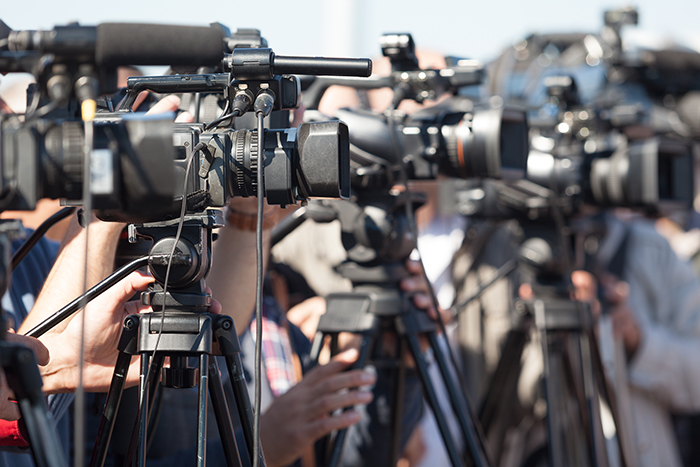 Each week, Index on Censorship’s Mapping Media Freedom project verifies threats, violations and limitations faced by the media throughout the European Union and neighbouring countries. Here are five recent reports that give us cause for concern.
Each week, Index on Censorship’s Mapping Media Freedom project verifies threats, violations and limitations faced by the media throughout the European Union and neighbouring countries. Here are five recent reports that give us cause for concern.
Turkey’s main internet regulator, Information and Communication Technologies, sent instructions to operators to close VPN services, according to technology news site Webtekno.
The ICT said it was acting within the scope of Article 6, paragraph 2 of law no 5651 in adopting a decision requesting Turkish operators to shut down VPN services.
The decision covers popular encryption services as Tor Project, VPN Master, Hotspot Shield VPN, Psiphon, Zenmate VPN, TunnelBear, Zero VPN, VyprVPN, Private Internet Access VPN, Espress VPN, IPVanish VPN.
According to Webtekno some VPN services are still available such as Open VPN.
“This is clearly detrimental to journalists and the protection of their sources,” Hannah Machlin, project officer for Mapping Media Freedom, said.
Turkey’s internet censorship did not stop with VPNs as the country faced a shutdown of the popular social media sites Facebook, YouTube, Twitter and more. This was the first time in recent years that the Turkish government targeted popular messaging apps such as WhatsApp, Skype and Instagram, according to Turkey Blocks.
The Independent states that it’s unclear whether the social media outage came from an intentional ban, an accident or a cyber attack. Turkey Blocks believes the outage was related to the arrest of political activists for the opposition party the previous night.
Turkey has increasingly utilised internet restrictions to limit media coverage in times of political unrest.
Spanish group Morera and Vallejo, has decided to slash contracts with photographers working for their newspaper, El Correo de Andalucía, according to the Sevilla Press Association (APS).
The three photographers working as “fake” freelancers for the newspaper were on a permanent contract without the benefits of being an employee. New contracts for the photographers worsened their conditions, lowering their pay and lessening the work photographers can put in daily.
APS additionally states that journalists working for El Correo de Andalucía are expected to act as photographers as well, doubling the amount of work they must put in. The newspaper pushed for the merging journalism and photography but journalists are unwilling to steal their coworkers’ jobs.
Four journalists from the Center for Investigative Reporting in Serbia (CINS) have noted that they have been followed and photographed on mobile phones by unknown individuals, NUNs Press reported.
CINS, which is known for reporting on corruption and organised crime in Serbia, believes the stalkers are an attempt to intimidate their journalists. Editor-in-chief Dino Jahic stated that they’re unsure who is behind the harassment, “We are working on dozens of investigations all the time, and each of them could trigger somebody’s anger.”
On its website, CINS wrote that they were determined to continue their investigations despite the intimidation. Their case has been reported to the Ministry of Interior and the public prosecutor’s office in Belgrade.
The online investigative news site Ukrayinska Pravda has reported that Ukrainian authorities wiretapped the outlet’s offices during the summer of 2015.
Editor-in-chief Sevgil Musayeva-Borovyk said in March of 2016, an unidentified person handed in an envelope with operational reports, activities and topics recently discussed by UP. The site has no evidence that wiretapping has continued since then.
According to Ukrayinska Pravda, the security service of Ukraine was carrying out orders from the president’s administration. Ukrayinska Pravda reported that it was not only its journalists that were targeted, claiming the staff of several other media sites have been tapped. Mapping Media Freedom does not yet know which other organisations.
Journalists have asked the security service of Ukraine, interior minister and chairman of the national police to respond to the information UP has gathered.[/vc_column_text][/vc_column][/vc_row][vc_row][vc_column][vc_column_text]
Click on the bubbles to view reports or double-click to zoom in on specific regions. The full site can be accessed at https://mappingmediafreedom.org/
[/vc_column_text][vc_basic_grid post_type=”post” max_items=”4″ element_width=”6″ grid_id=”vc_gid:1478786551399-adbbd256-7b8d-7″ taxonomies=”6564″][/vc_column][/vc_row]
16 Sep 2016 | mobile, News and features, Tim Hetherington Fellowship, United Kingdom
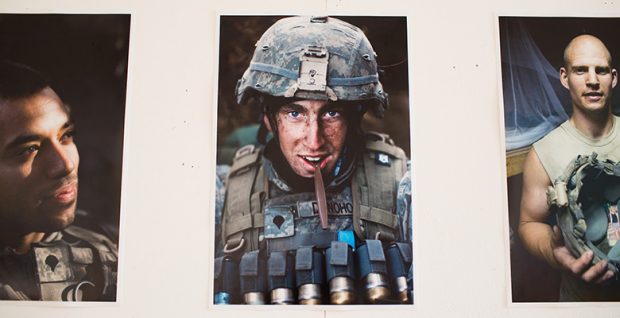
Photo: Liverpool John Moores University
Liverpool John Moores University officially opened its Infidel exhibition, a display of photographs by Tim Hetherington, on Wednesday night. The Liverpool-born photojournalist, who died in Libya under mortar fire in 2011, took the photos during the year he spent embedded with the US Army in Afghanistan’s Korangal Valley while shooting his 2010 Oscar-nominated documentary Restrepo.
Stephen Mayes, a personal friend of Hetherington’s and the director of the Tim Hetherington Trust, spoke at the launch, and highlighted three moments from Hetherington’s short film Diary, which he felt summed up the photographer’s feelings about dividing his time between west London and west Africa. Mayes also recalled a conversation he had with Hetherington around a month before his death, about how photography is great at portraying the “hardware” of war – the guns, the bombs, the carnage – but that Hetherington preferred to work with what he called the “software”, the young men who fight and the people caught in the middle.
The photographs in the Infidel exhibit are a perfect example of what was so impressive about Hetherington’s work. Despite having weathered a year of almost constant combat alongside a platoon of US soldiers, he took striking images that stepped back from the front line. His portraits featured men hugging, relaxing and playing games, highlighting their individual humanity and vulnerability in an environment that treats them as means to an end.
As the new recipient of the Tim Hetherington Fellowship, the result of Index on Censorship’s collaboration with the trust and LJMU (where I graduated in journalism), I’m inspired by the spirit of that work. I’m struck by the bravery and moral fortitude of a man who frequently put himself in harm’s way out of a sense of duty to the people around him. His determination to immerse himself in the lives of his subjects and portray the emotional truth of their experience has reminded me why I always wanted to be a journalist. Journalism is about letting people tell their stories.
Index on Censorship fights for the rights of people to be heard. Hetherington spent his life trying to tell untold stories. It’s an honour to be part of his legacy.
Infidel is open now at the John Lennon Art and Design Building, Duckinfield Street, Liverpool until Friday September 23. Admission is free, 10am to 5pm, Monday to Friday.
6 Aug 2015 | mobile, News and features, South Africa
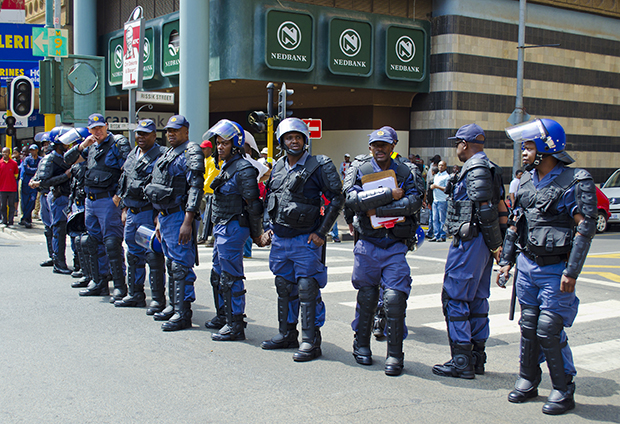
Despite Standing Order 156 incidents of police harassment of journalists continues. (Photo: Jaxons / Shutterstock.com)
Raymond Joseph has joined Index as a columnist
Working as a reporter in the spiraling cauldron of violence in South Africa of 70s and 80s, I learned early on to be wary of the police, who would often harass, bully and even detain journalists for doing their job.
Often it happened when police, armed to the teeth, went into operational mode, firing teargas, baton rounds and even live ammunition to brutally break up protests.
While reporters were also targeted, it was photographers and cameramen who were really in the firing line. Toting cameras, they were easily visible. Their pictures or footage were regularly destroyed by police and their equipment damaged or confiscated.
As a young reporter, I became adept at stashing exposed rolls of film, slipped to me by photographer colleagues, down the front of my trousers to hide them from the police.
Anyone who worked as a journalist in those turbulent times has stories to tell of being pushed around and bullied by the police who saw the media, especially those working for the anti-apartheid era English language Press, as “the enemy”.
Fast forward two decades into post-apartheid South Africa and practically every working journalist also has a story of police harassment to tell, often arising from incidents when they were reporting or filming police officers. Many less serious incidents go unreported, accepted by journalists as part of the job.
This is happening despite the South African Police Service’s own Standing Order 156 that sets out how the police must behave towards the media. The language used is unequivocal and leaves no room for misunderstanding. It makes it clear that police cannot stop journalists from taking photos or filming, including photographing police officers. It also states that “under no circumstances” may media be “verbally or physically abused” and “under no circumstances whatsoever, may a member willfully damage the camera, film, recording or other equipment of a media representative.”
Yet despite high-level meetings between media and the police’s top brass, who say that such actions are not condoned, incidents continue to occur. The most recent meeting was in June this year between the South African National Editors’ Forum (SANEF) and the Johannesburg Metro Police after a photographer and TV cameraman were roughed up when they filmed officers arresting a drunk driver.
Incidents are happening so regularly that the Right2Know Campaign has published a booklet and cards explaining their rights for journalists to give to police if they are interfered with while on the job.
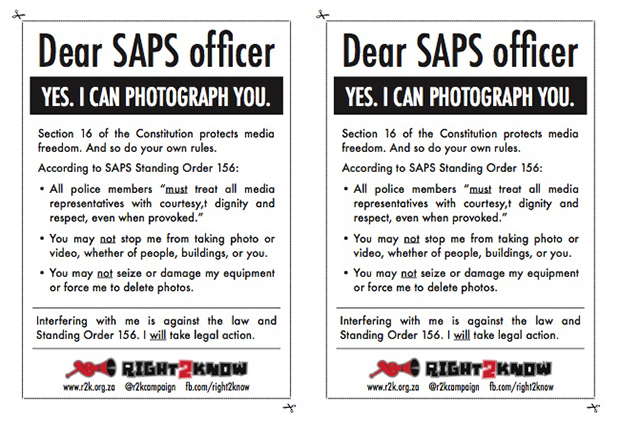
But, problematically, Standing Order 156 only deals with media and makes no mention of civilians who film the police using mobile phones.
“One shortcoming that we discovered in putting this together is that there isn’t enough protection for bystanders with cell phones,” says R2K spokesman Murray Hunter. “Under the Constitution, everyone has the same right to freedom of expression – working journalists and ordinary people alike. It’s especially important since bystanders with cell phones are often sources for mainstream media.
“But the direct orders that we refer to in this advisory only instruct police not to interfere with old-school media workers. So bystanders may still find themselves in a situation where the Constitution recognises their right to freedom of expression, but a police officer on the ground doesn’t.”
An example of the important role now played by citizens in newsgathering is the video footage shot by a bystander on a mobile phone of police brutalising taxi driver Mido Macia for an alleged minor parking offence. Sent anonymously to the Daily Sun newspaper, it led to the dismissal of nine policemen, who are now on trial for the killing of Macia.
One beacon of hope is that Standing Order 156 is under review after SANEF complained to the police about repeated media harassment. R2K sees this as an opportunity to include protection of the rights of citizen reporters, as well as media professionals, says Hunter.
But that could take time and involve protracted negotiations. And even if it happens there is no guarantee that police will heed the force’s own rules, or that the harassment of journalists and others will end.
It seems that the more things change, the more they will stay the same.
This column was posted on 6 August 2015 at indexoncensorship.org
25 Sep 2014 | News and features, Religion and Culture, United States
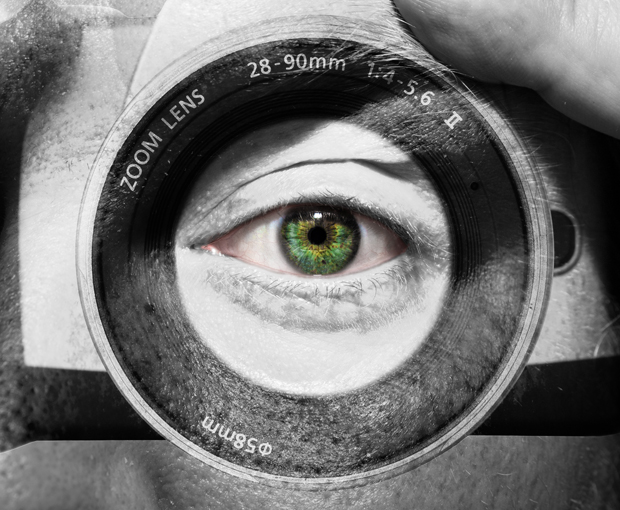
(Photo: Shutterstock)
For us jaded Europeans, the United States’ first amendment, with its simple pledge that the government will keep out of the business of religion and censorship, seems as stubbornly, oafishly American as Hulk Hogan. It’s a loud tourist with a bumbag, wasting his money in an Angus Steakhouse; it’s Burt Reynolds’ moustache; it’s Jane Russell’s specially-constructed brassiere; it’s brash and unsubtle and does not do nuance.
Which is why we’re so ready to accept the idea that a US court has decided that the first amendment concept of free speech trumps all, even sexual harassment. Especially if that court is in Texas, the bit, we imagine, that makes the rest of the United States look sophisticated.
“Texas court upholds right to take ‘upskirt’ pictures”, said the Guardian, while the Independent tweeted “You’re legally allowed to take upskirt pictures in Texas because it’s ‘freedom of expression’” (note the scare quotes).
The stories under the headlines concerned a ruling by the Texas Court of Criminal Appeals in a case concerning a man named Ronald Thompson.
Thompson had been caught taking pictures of children and women at a water park in San Antonio, focusing on what I believe is called the “bikini area”. Thompson reportedly tried to delete the photos as he was apprehended. He was indicted on 26 counts under Texas’ “improper photography or visual recording” law.
Thompson appealed the indictments on the grounds that the law was incompatible with the first amendment. The court agreed with him, leading to the headlines across the world. Most reports, including, it should be said, the American ones, went hard on the “upskirt” or “creepshot” angle, declaring it was now entirely legal to well, be a creep with a camera in Texas.
Is it really? Well, sort of, ish.
The judgement issued by the court is a genuinely fascinating read for anyone interested in free expression, far from the gun-toting, sexual harassment-ignoring, good ole boy decision it has been represented as. It involves discussion about what constitutes the public realm and the nature of consent. It goes into some detail as to whether the act of photography is in itself creative expression, and decides it is.
Some commentators, such as Salon’s Jenny Kutner have picked up on the wording in the judgment suggesting that “Protecting someone who appears in public from being the object of sexual thoughts seems to be the sort of ‘paternalistic interest in regulating the defendant’s mind’” as evidence of a court being more interested in a pervert’s right to perv than a woman’s right not to be harassed.
But it’s actually a point well worth making. Courts and governments cannot be involved in what people find sexually arousing in their imaginations; it’s only if actions cause harm to others that the law should intervene.
This is not, then, a ruling taken lightly. Rather it reviews very seriously a badly written law.
The law itself, section 21.15 of the Texas Penal Code, reads as follows:
(b) A person commits an offense if the person:
(1) photographs or by videotape or other electronic means records, broadcasts, or transmits a visual image of another at a location that is not a bathroom or private dressing room:
(A) without the other person’s consent; and
(B) with intent to arouse or gratify the sexual desire of any person;
The “bathroom or private dressing room” exclusion seems weird, but is only there because the next clause specifically refers to bathrooms and private dressing rooms, presumably drafted in light of some kind of Chuck Berry scenario (the guitar legend was accused of secretly taping people using bathrooms in his Missouri restaurant).
The problem is that this is far too broadly drawn as a law, but also weirdly specific. What it does not address at all is what might be a reasonable expectation of privacy in public: it is not a serious argument to suggest that one must always actively give consent to being photographed in public space. But it is reasonable to expect that no one should be taking upskirt pictures of you: the judgment acknowledges as much, specifically mentioning upskirt photographs as an “intolerable” breach of privacy.
The weird specificity comes with the “sexual desire” bit; why is this kind of thought worse than any other? Shouldn’t the focus be on the breach (or not) of privacy, rather than what thoughts the images might lead to? Apart from the argument over whether photography is an act of expression, it is this clause that raises free expression problem with the law: put simply, the human mind is capable of eroticising pretty much anything. Any kind of picture could “arouse or gratify the sexual desire of any person”. Once again, the focus is in fact taken away from the act of breaching privacy and towards the act of expression.
In spite of initial appearances, the Texans have done a good thing here. The state will now have to come up with a law that properly balances privacy and free expression, rather than giving just piecemeal thought to either concept.
First amendment cases often solicit astonished responses. But more often than not, a first amendment consideration isn’t just free expression rolling into town in its monstrous, burger chewing, gasoline drinking, Okie from Muskogee way. No. More often than not, the first amendment forces some real thought and analysis to take place in public life.
This article was posted on Thursday, September 25, 2014 at indexoncensorship.org
 Each week, Index on Censorship’s Mapping Media Freedom project verifies threats, violations and limitations faced by the media throughout the European Union and neighbouring countries. Here are five recent reports that give us cause for concern.
Each week, Index on Censorship’s Mapping Media Freedom project verifies threats, violations and limitations faced by the media throughout the European Union and neighbouring countries. Here are five recent reports that give us cause for concern.



